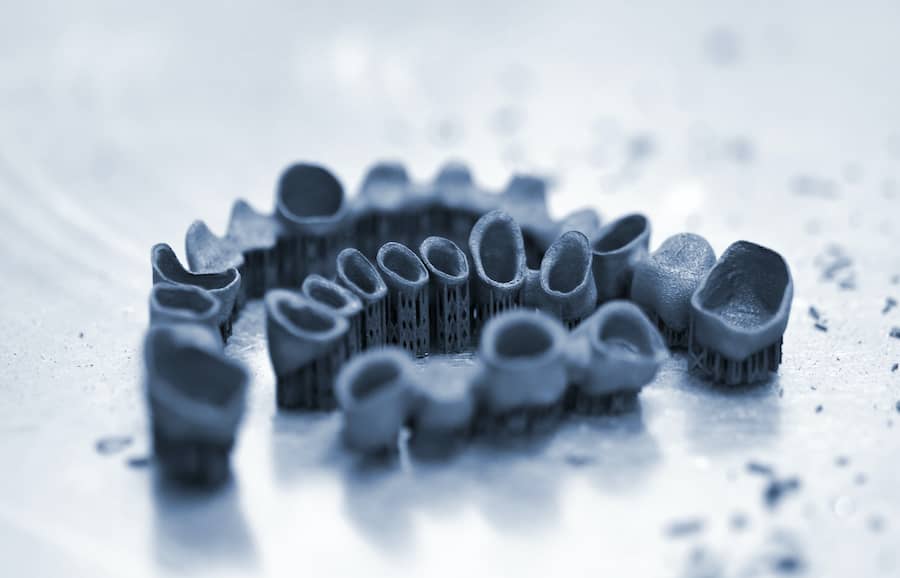Ti64Gr23, A Low-Oxygen Titanium Alloy for 3D Printing
Hempel Special Metals
Titanium alloys have many favourable properties, and titanium powders have gained traction as ideal materials for 3D printing in recent years. So, why is that? And what, in particular, makes Ti64Gr23 powder a good choice?
The Ti64Gr23 alloy, produced in the form of powder, is mainly used as feedstock in additive 3D printing. It is one of many titanium alloys produced by Hempel Special Metals and is typified by its very low levels of oxygen, less than 0.11 ma%. The very small sizes of the spherical alloy particles are advantageous for additive manufacturing, especially when trying to create smaller and/or more intricate parts. The small spherical particle size distribution (as low as 15 μm and no higher than 53 μm) results in a high packing density and good rheological characteristics. It also has a homogenous microstructure which can be improved by heat treatment. These morphological characteristics make the alloy compatible with 3D metal printing techniques, such as selective laser melting (SLM) and direct metal deposition (DMD).

Introducing the Ti64Gr23 alloy
The Ti64Gr23 alloy, also known as Grade 23 Ti6Al4V ELI alloy (ELI stands for extra-low interstitials), has a chemical composition of 5.5 – 6.5% aluminium, ≤ 0.08% carbon, ≤ 0.03% nitrogen, ≤ 0.012% hydrogen, 3.5 – 4.5% vanadium, 0.005% yttrium and ≤ 0.25% iron. The rest of the alloy is made up of titanium, the base metal.
The alloy is a member of the Ti6Al4V alloy family which consists of two main commercial grades: Ti6Al4V grade 5, and Ti6Al4V grade 23. The compositions of these alloys are essentially the same and they are only differentiated by the reduced limits on the interstitial elemental components (impurities that can impact the mechanical properties of the alloy). Grade 23 has greater ductility and fracture toughness than grade 5 but has reduced strength.
Titanium alloys can be categorised into three main groups: α-phase, β-phase, and α-β-phase depending on the microstructure of the grains of the material. Ti64Gr23 is an alpha-beta phase alloy, which means it has both the alpha and beta phases present in its microstructure. The phase of the alloy is primarily dependent on the heat treatment process that has been adopted and the alloying elements that have been added to the titanium.
Ti64Gr23 is manufactured by the electrode induction gas atomisation process (EIGA), a ceramic-free, induction-heated manufacturing process that is used to produce metal powders of very high purity. The process creates a continuous flow of molten alloy, which is blown with a high-velocity jet of inert gas (usually Argon or Nitrogen) as it falls through a slit. This jet of inert gas atomises the melt into micro-droplets. These droplets solidify into smooth spheres of very small sizes and are collected in airtight containers to protect them from contamination and moisture.
Properties of the Ti64Gr23 alloy
Perhaps the most important features of the Ti64Gr23 alloy are its high strength-to-weight ratio (titanium has the highest strength-to-weight ratio of any metal), excellent general corrosion resistance, chemical inertness and biocompatibility. Furthermore, it has high fracture toughness and fatigue strength.
These properties all make the alloy very attractive for the manufacture of special parts via 3D metal printing. With skill and expertise, the alloy is amenable to various fabrication techniques, such as welding, forming and machining. It is also heat treatable via annealing, cold working, hot working, forging and ageing.
For powder bed-based 3D metal printing, only a fraction of the alloy in build volume is consumed. The leftover powder that has been exposed to the fusion environment within the build chamber may have its quality compromised as the average particle size may have increased due to the agglomeration of particles under heat. The initial low size distribution of Ti64Gr23 makes it possible for greater reuse even after exposure to heat as a significant percentage of the particles still falls within the particle size specification, and they may be mixed with virgin powder to ensure this.
Some of the properties of the Ti64Gr23 alloy are outlined in the table below.
Table 1. Properties of Ti64Gr23 alloy
|
General properties |
|
|
Density |
4.43 g/cm3 |
|
Mechanical properties |
|
|
Elongation |
10% |
|
Tensile strength |
860 MPa |
|
Yield strength Rp0.2 (MPa) |
780 MPa |
|
Modulus of elasticity (Young) |
113.8 GPa |
|
Shear Modulus |
44.0 GPa |
|
Poisson’s ratio |
0.342 |
|
Hardness (Rockwell) |
35 |
|
Thermal properties |
|
|
Coefficient of thermal expansion |
8.60 µm/m°C |
|
Thermal conductivity at 87°C |
6.70 W/m.K |
Applications of the Ti64Gr23 alloy
The Ti64Gr23 alloy has extensive application in the medical field as bone/dental implants, prostheses, osteosyntheses and surgical tools. It complies with the F136 ASTM standard for surgical implant applications and the ASTM B348 standard specification for titanium and titanium alloy bars and billets. It has further applications in:
- Aerospace and aircraft components
- High-pressure cryogenic applications
- Prototype development
- Jewellery and watchmaking
- Marine applications
- The defence industry

How you can find and use the Ti64Gr23 alloy
The low oxygen content of Hempel’s Ti64Gr23 is important as some medical specifications require a limit on the oxygen content of the part. This low content also allows for greater reusability of leftover powder as there tends to be oxidation over time, ensuring that the final oxygen content remains within specification.
Hempel Special Metals AG is an international group of companies that produces and supplies a wide range of materials, and they are headquartered in Duebendorf, Switzerland.
Article by Hempel Special Metals
International Group distributing and processing of High Performing Materials for various industries with HQ in Switzerland

